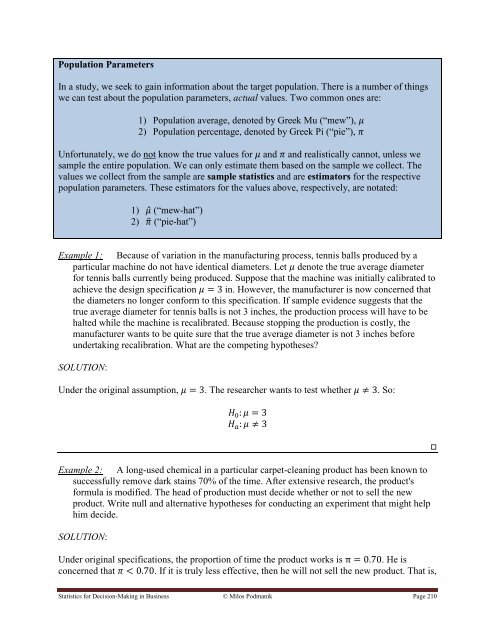Statistics for Decision- Making in Business - Maricopa Community ...
Statistics for Decision- Making in Business - Maricopa Community ...
Statistics for Decision- Making in Business - Maricopa Community ...
Create successful ePaper yourself
Turn your PDF publications into a flip-book with our unique Google optimized e-Paper software.
Population Parameters<br />
In a study, we seek to ga<strong>in</strong> <strong>in</strong><strong>for</strong>mation about the target population. There is a number of th<strong>in</strong>gs<br />
we can test about the population parameters, actual values. Two common ones are:<br />
1) Population average, denoted by Greek Mu (“mew”),<br />
2) Population percentage, denoted by Greek Pi (“pie”),<br />
Un<strong>for</strong>tunately, we do not know the true values <strong>for</strong> and and realistically cannot, unless we<br />
sample the entire population. We can only estimate them based on the sample we collect. The<br />
values we collect from the sample are sample statistics and are estimators <strong>for</strong> the respective<br />
population parameters. These estimators <strong>for</strong> the values above, respectively, are notated:<br />
1) ̂ (“mew-hat”)<br />
2) ̂ (“pie-hat”)<br />
Example 1: Because of variation <strong>in</strong> the manufactur<strong>in</strong>g process, tennis balls produced by a<br />
particular mach<strong>in</strong>e do not have identical diameters. Let denote the true average diameter<br />
<strong>for</strong> tennis balls currently be<strong>in</strong>g produced. Suppose that the mach<strong>in</strong>e was <strong>in</strong>itially calibrated to<br />
achieve the design specification <strong>in</strong>. However, the manufacturer is now concerned that<br />
the diameters no longer con<strong>for</strong>m to this specification. If sample evidence suggests that the<br />
true average diameter <strong>for</strong> tennis balls is not 3 <strong>in</strong>ches, the production process will have to be<br />
halted while the mach<strong>in</strong>e is recalibrated. Because stopp<strong>in</strong>g the production is costly, the<br />
manufacturer wants to be quite sure that the true average diameter is not 3 <strong>in</strong>ches be<strong>for</strong>e<br />
undertak<strong>in</strong>g recalibration. What are the compet<strong>in</strong>g hypotheses<br />
SOLUTION:<br />
Under the orig<strong>in</strong>al assumption, . The researcher wants to test whether . So:<br />
Example 2: A long-used chemical <strong>in</strong> a particular carpet-clean<strong>in</strong>g product has been known to<br />
successfully remove dark sta<strong>in</strong>s 70% of the time. After extensive research, the product's<br />
<strong>for</strong>mula is modified. The head of production must decide whether or not to sell the new<br />
product. Write null and alternative hypotheses <strong>for</strong> conduct<strong>in</strong>g an experiment that might help<br />
him decide.<br />
SOLUTION:<br />
Under orig<strong>in</strong>al specifications, the proportion of time the product works is . He is<br />
concerned that . If it is truly less effective, then he will not sell the new product. That is,<br />
<strong>Statistics</strong> <strong>for</strong> <strong>Decision</strong>-<strong>Mak<strong>in</strong>g</strong> <strong>in</strong> Bus<strong>in</strong>ess © Milos Podmanik Page 210
















